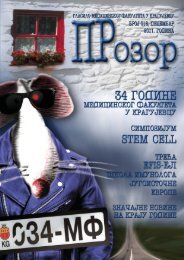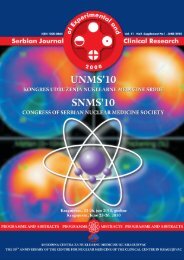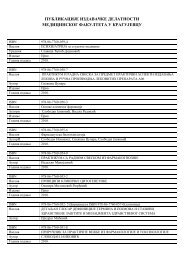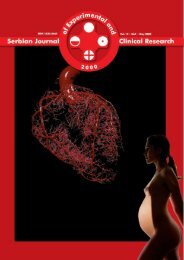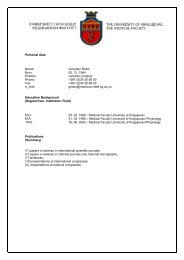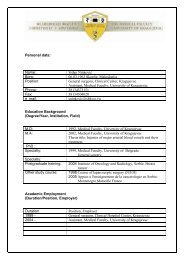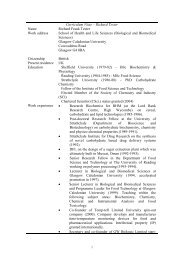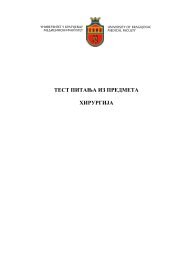in Table 2. The mass spectrum <strong>of</strong> DMP showed that themolecular ion (C 18H 25NO+, m/z = 271) signal representedapproximately 30% <strong>of</strong> the base peak (= 100%) at m/z = 59[C3H9N + ], indicating a moderate stability <strong>of</strong> the molecularion in gas phase compared with codeine [26].The main fragmentation pathway for DMP after ionisationat 8.83 eV consists <strong>of</strong> three principal pathways (paths1-3) as rationalised in scheme 1. The formation <strong>of</strong> the fragmention at signal m/z = 214 (path 1, scheme 1) with R.I.= 26.6% is mainly due to the formation <strong>of</strong> [M-C 3H 7N] + asa loss <strong>of</strong> the C 3H 7N bridge by disruption <strong>of</strong> the C 2–C 18<strong>and</strong>C 10–C 17bonds. It is worth mentioning that this fragmention, C 15H 18O+ (M-C 3H 7), was formed directly from themolecular ion. This formation was confirmed by the fullscan positive ion mass spectrum using t<strong>and</strong>em mass spectrometry(MS/MS) [6] as a prominent peak. Subsequentcleavage <strong>of</strong> the C 7–C 2<strong>and</strong> C 1–C 10bonds (ring B) occurredforming the C 6H 10+fragment ion (m/z = 82, R.I. = 12.5%)(path 1 scheme 1).Two important possible modes <strong>of</strong> fragmentation (paths2 <strong>and</strong> 3 scheme 1) are due to the cleavage <strong>of</strong> the two bondsß to the nitrogen atom (i.e., cleavage <strong>of</strong> C 1–C 10<strong>and</strong> C 9–C 10competitively forming two important fragment ions in themass spectrum.) First, cleavage <strong>of</strong> the C 1–C 10bond <strong>and</strong> formation<strong>of</strong> the most prominent fragment (the base peak) atm/z = 59 (path 2) <strong>of</strong> formula C 3H 9N. Also, cleavage <strong>of</strong> theC 9–C 10bond formed the second prominent peak at m/z =150 (R.I. = 83.0%) with the structure C 9H 12NO (path 3).Structural determinations for the compounds <strong>of</strong> unknownstructure are generally based upon informationobtained through the use <strong>of</strong> a variety <strong>of</strong> modern instruments.The instrumental methods usually include massspectrometric studies, <strong>and</strong> the techniques are well knownto organic chemists <strong>and</strong> scientists [32].It is known that DMP is chemically related to codeine[2] but that it differs in biological effect. DMP is an antitussiveagent used in many nonprescription cough <strong>and</strong>cold medications [1]. Codeine has an analgesic effect [26].Biotransformation (metabolites) in vivo <strong>and</strong> in vitro <strong>of</strong> thetwo drugs has been investigated by many investigators[3–6]. Metabolism studies <strong>of</strong>ten lead to compounds withunknown structures that are related to the material understudy. The chemical structure <strong>and</strong> metabolic pathway <strong>of</strong>DMP were rationalised [5] in Fig. 3.The metabolism <strong>of</strong> DMP is primarily by o-demethylationto dextrophan. DMP is also metabolised to 3-methoxymorphinan<strong>and</strong> 3-hydroxymorphinan.It was noted that from mass spectrum <strong>of</strong> DMP, the signaldue to C 2H 4loss was observed with minor abundancem/z = 243, R.I. = 1.21, which may be due to the formation<strong>of</strong> hydroxymorphinan.Comparing the fragmentation pathway <strong>of</strong> DMP to codeine[26], one can notice that the two drugs are similar inthe initial processes (i.e., loss <strong>of</strong> the bridge C 3H 7N <strong>and</strong> thering opening <strong>of</strong> the two bonds ßto the nitrogen atom). Thesubsequent fragmentation differed because <strong>of</strong> the presence<strong>of</strong> different substituent groups (O <strong>and</strong> OH).ComputationMolecular orbital calculations gave valuable informationregarding the structure <strong>and</strong> reactivity <strong>of</strong> the molecules<strong>and</strong> molecular ions. The computational data supportsthe experimental data. The parameters calculatedusing the MO calculation include geometry, bond order,bond strain, charge distribution, heat <strong>of</strong> formation <strong>and</strong>ionisation energy.The investigation <strong>of</strong> the molecular structure <strong>of</strong> DMPwith the common formula C 18H 25NO was <strong>of</strong> interest in thiswork, <strong>and</strong> this investigation aimed to predict the weakestbond cleavage <strong>and</strong> the stability <strong>of</strong> the neutral molecule byTA <strong>and</strong> the charged molecular by MS.Table 3 shows the comparison <strong>of</strong> computed bondlength, bond order <strong>and</strong> bond strain using the PM3 methodfor neutral <strong>and</strong> molecular cationic forms. Table 4 shows acomparison <strong>of</strong> computed partial charges <strong>of</strong> neutral <strong>and</strong>charged species. The computations reveal some importantresults.1 The charge density localised on the nitrogen atom increasedfrom -0.076 to 0.489 from a neutral to chargedatom, which reveals that the electron disruption uponionisation at 8.83 eV occurs in the nitrogen atom. Noappreciable change in the charge on the other atom wasdue to ionisation <strong>of</strong> the molecule.2 C 2–C 18is the lowest bond order for neutral molecule(0.964) <strong>and</strong> charged cationic form (0.967).Correlation <strong>of</strong> TA, MS <strong>and</strong> MO-calculations.DMP is an essential cough <strong>and</strong> cold medication [1].The drug is chemically related to codeine [2]. As indicatedpreviously [32], a determination <strong>of</strong> initial bond cleavage isan important first step.The scope <strong>of</strong> this investigation was restricted to asearch or prediction <strong>and</strong> discerned the features <strong>of</strong> initialbond disruption during the course <strong>of</strong> fragmentation <strong>of</strong>DMP. Empirical observations indicate that the course <strong>of</strong>subsequent fragmentation is determined to a large extentby the initial bond disruption <strong>of</strong> the molecular ion in MS[34]. It is quite acceptable to say that the computationalquantum chemistry can provide additional data, whichcan be used successfully to interpret both TA <strong>and</strong> MSexperimental results. These theoretical data are particularlyvaluable for mass spectral scientists. These scientistsstudy gas-phase species, which can be h<strong>and</strong>led muchmore easily by quantum chemistry [33].The mass spectrum <strong>of</strong> DMP in gas-phase ion revealedthree competitive processes (1 – 3, scheme 1).PM3 calculation (Table 3) revealed that C 10–N 17wasthe weakest bond in the charged system (weakest bondorder at 0.961, large bond length = 1.484 Aº <strong>and</strong> bondstrain). Moreover, the weakness <strong>of</strong> this bond (C 10–N 17)was due to the presence <strong>of</strong> a lone pair on the nitrogen. Table3 shows that the electron disruption upon ionisationoccurred from the nitrogen, which increased the weak-25
BondBond length (Å) Bond order Bond strain (k Cal/mol)Neutral Ionic Neutral Ionic Neutral IonicC1-C2 1.541 1.542 0.965 0.970 0.206 0.189Cl-C6 1.525 1.531 0.984 0.983 0.049 0.208Cl-C10 1.533 1.542 0.973 0.962 0.049 0.101C2-C3 1.548 1.547 0.969 0.971 0.457 0.639C2-C7 1.518 1.520 0.969 0.974 0.252 0.290C3-C4 1.519 1.519 0.993 0.996 0.034 0.071C4-C5 1.518 1.515 0.992 0.997 0.107 0.004C5-C6 1.526 1.522 0.987 0.992 0.174 0.095C7-C8 1.403 1.405 1.376 1.365 0.082 0.140C7-C14 1.395 1.393 1.424 1.442 0.084 0.097C8-C9 1.493 1.491 0.990 0.997 0.035 0.058C8-C11 1.396 1.397 1.409 1.401 0.044 0.047C9-C10 1.533 1.535 0.971 0.959 0.073 0.115C11-C12 1.388 1.387 1.429 1.444 0.007 0.003C12-C13 1.389 1.401 1.373 1.360 0.015 0.010C13-C14 1.400 1.405 1.371 1.351 0.012 0.015C13-C15 1.382 1.372 1.029 1.067 0.038 0.038C15-C16 1.406 1.409 0.987 0.980 0.008 0.009C10-N17 1.503 1.484 0.972 0.961 0.226 0.192C2-C18 1.545 1.547 0.964 0.967 0.118 0.178C18-C19 1.524 1.525 0.990 0.980 0.075 0.031N17-C20 1.480 1.450 0.997 1.013 0.057 0.063C19-N17 1.492 1.460 0.980 0.994 0.092 0.059Table 3: Comparison <strong>of</strong> computed bond length, bond order <strong>and</strong> bond strain (k Cal mol -1 ) using PM3 method for neutral <strong>and</strong> molecular cation.ness <strong>of</strong> the bond. After an easy disruption <strong>of</strong> this bond,the subsequent bond is C 2–C 18(bond order = 0.967, bondlength = 1.54 7Aº <strong>and</strong> bond strain = 0.178 K cal mol -1 ). Disruption<strong>of</strong> these two bonds (C10–N 17<strong>and</strong> C 2–C 18) formeda fragment ion at m/z = 214 by loss C 3H 7N (bridge) fromthe molecular ion. The subsequent loss <strong>of</strong> C 9H 11O (rupture<strong>of</strong> the B ring) formed the fragment ion C 6H 10at m/z = 82,which can lead to a loss <strong>of</strong> H 2to form the fragment ionC 6H 8at m/z = 80 (process 1, scheme 1). One can concludethat process 1 is the principal one for DMP, which can helpto interpret TA decomposition.The primary TA decomposition <strong>of</strong> DMP (wt loss =4.1%) between 100 ºC <strong>and</strong> 150ºC was mainly due to loss<strong>of</strong> water. It was followed by a mass loss <strong>of</strong> 32.5% between150 ºC <strong>and</strong> 350ºC. On the basis <strong>of</strong> the MO calculation(Table 2), C 2–C 18was the first bond cleavage <strong>of</strong> neutralsystem having the lowest bond order at 0.964 with a longbond length (1.545 ºA) <strong>and</strong> large bond strain (0.118 k calmol -1 ) followed by C 10–N 17(bond order = 0.972, bondlength = 1.503 Aº <strong>and</strong> bond strain = 0.226 k cal mol -1 ).As a result <strong>of</strong> the disruption <strong>of</strong> these two bonds, C 2–C18<strong>and</strong> C 10–N 17lost the bridge C 3H 7N. The wt loss <strong>of</strong> 32.5%resulted from the bridge <strong>and</strong> HBr molecule (C 3H 7N +HBr). The subsequent third mass loss <strong>of</strong> 54.57% occurredat 350-450ºC <strong>and</strong> may be attributed to the loss <strong>of</strong>OCH 3C 6H 4CH 2CH 2(i.e., C 9H 11O) via the cleavage <strong>of</strong> theB-ring (C 2–C 7<strong>and</strong> C 1–C 10).The final mass loss <strong>of</strong> 5.68%, which occurred at temperaturerange 450-600ºC, may be attributed to the loss <strong>of</strong> theremainder <strong>of</strong> the drug molecule. It is possible to rationalisethe thermal degradation scheme 2 as follows.The dextromethorphan (DMP-HBr) neutral compoundis stable up to 150ºC before being fragmented by the loss<strong>of</strong> the bridge C 3H 7N + HBr, whereas codeine fragments at160 o C [26]. In contrast, the molecular ion <strong>of</strong> DMP is RI =30%, while the molecular ion <strong>of</strong> codeine is considered thebase peak (RI = 100%). This high stability <strong>of</strong> codeine maybe due to the presence <strong>of</strong> OH <strong>and</strong> O atoms in its skeleton.This work provides further insights into utility <strong>of</strong> experimentalTA <strong>and</strong> MS techniques <strong>and</strong> a theoretical investigationwith MO calculation using the semi-empiricalPM3 procedure on DMP. From the practical <strong>and</strong> theoreticaltechniques, we concluded that the primary fragmentation<strong>of</strong> DMP is initiated by the loss <strong>of</strong> C 3H 7N + HBr in26




